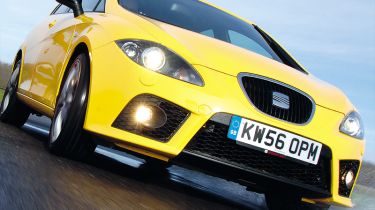SEAT Leon Cupra (2005-2012) review
Hot hatch fans shouldn’t ignore the Cupra. It has great acceleration and grip.

Driving
The highlight of the Cupra is the 2.0T FSI engine, which is fitted with a larger turbocharger than the FR (both units are derived from the Golf GTI). You would expect a bigger turbine to increase lag due to its inertia, but that isn’t the case here, and it responds every bit as rapidly as the FR’s 197bhp unit. However, despite the significant power increase, torque remains at 280Nm, although it is delivered at a lowly 1,750rpm. Nevertheless, the Cupra isn’t held back. It has excellent traction off the line and rocketed to 60mph in 6.1seconds. On the road, this actually translates into quite a calm experience, as the torque helps you out of trouble. Yet even under hard acceleration, the only noise is a light whistle from the turbo and a slight burble from the exhaust. Impressively, it transfers its power to the road well, with little torque steer. The ride is surprisingly supple too, dealing with potholes well and not fidgeting or crashing on uneven surfaces. It’s not only more sporting, but more relaxing than the FR. There’s plenty of grip, and body control is excellent, while the steering is precise and well weighted. However, it does lack a little feedback, so while it’s secure and composed, there’s not as much driver involvement as we’d like.
Marketplace
The Leon Cupra has one immediate claim to fame – it’s the most powerful roadgoing car SEAT has ever produced. Its 237bhp matches the Vauxhall Astra VXR, though both sit behind the unruly 256bhp Mazda 3 MPS. Yet the Cupra doesn’t shout about its potency. Previous-generation Cupras were often criticised for being garish, and it appears the Spanish firm has taken that on board. The latest Cupra is a much more grown-up performance machine, and as with the lower-spec FR model, it makes the most of the basic car’s stylish and sporty lines. There’s very little to distinguish it from its less powerful hatch brother though. Cupra lettering replaces the standard Leon badge, but that aside, the only differences are a black front lip spoiler, mirrors and door pillars, plus an oval exhaust pipe. The 18-inch alloys are also unique to this model.
Owning
Build quality is good, but some of the materials are disappointing, particularly the hard plastic on the centre console and instrument cluster. It neither feels special nor particularly sporty – it’s at odds with the athletic exterior, which boasts neat details such as the hidden rear doorhandles. OK, the seats are more special, and there’s a metal-topped gearlever and steering wheel insert, but this is still little to get excited about. The stereo is low rent too – and while equipment is decent, it doesn’t particularly compensate for a steep list price, even though Leons are currently posting some impressive retained values. It’s expensive to fuel, too (we averaged 25.2mpg), while initial insurance quotes bordered on the obscene! Though the group 17-ranked car should enjoy cheaper quotes as more insurers place it on their books.
Engines, performance and drive
0MPG, CO2 and Running Costs
0Interior, design and technology
0Practicality, comfort and boot space
0Reliability and Safety
0More reviews
Car group tests
In-depth reviews
Long-term tests
Road tests
Used car tests
Which Is Best
Most Economical
- Name1.5 e-Hybrid FR 5dr DSG [Driver Assistance Pack]
- Gearbox typeSemi-auto
- RRP£36,455
Fastest
- Name1.5 e-Hybrid FR 5dr DSG [Driver Assistance Pack]
- Gearbox typeSemi-auto
- RRP£36,455







